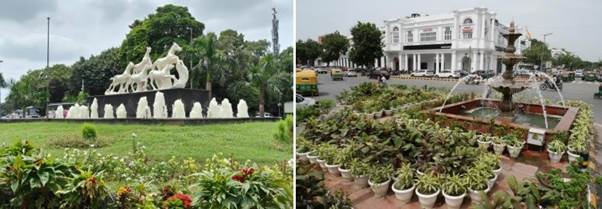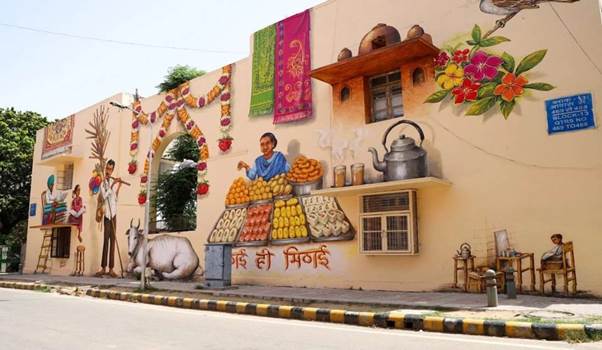National Capital shines amongst swachh cities
Marked by a robust monitoring system and strategic integration of innovative technologies to optimize waste management processes, New Delhi ranks 7th amongst the cleanest cities in India in the more than 1 lakh population category.

New Delhi Municipal Council has taken a proactive approach to sustainable waste management by setting up 6 community Organic Waste Converters in residential areas. Through door-to-door initiatives, organic waste is collected and composted at these facilities. To further encourage participation, bins for home composting were distributed, resulting in over 1,500 households engaging in home composting during a survey.

In addition, comprehensive guidelines have been provided to Bulk Waste Generators (BWGs) which are practising on-site waste processing of Wet waste as a sustainable waste management practice, fostering a greener and more environmentally conscious community.
The NDMC has implemented several important measures, such as significantly enhancing the resolution of Service Level Agreement (SLA) issues. Out of the 3,270 complaints that were registered, an impressive 3,022 were successfully resolved within the SLA timeline. The implementation of daily door-to-door collection has eliminated traditional dumping sites (Dhalaos), which have been transformed into efficient Roll Call centers for SafaiKarmis. The deployment of 36 GPS-enabled vehicles for MSW collection ensures a streamlined process.

In terms of Monitoring and Transparency, the Integrated Command and Control Centre plays a crucial role in monitoring vehicle movements, providing auto tipper routes and timings via the NDMC 311 App and website. A dedicated dashboard has been developed for waste processing integration, allowing live monitoring of auto tippers on the NDMC website.
In order to ensure effective waste processing, no waste goes to landfill site and there are no Dhalaos in the area the city has shared Waste-to-Energy (WTE) Plant in Okhla which is handling an average of 200 tons per day dry waste without resorting to landfills. Apart from that, work is underway for 6 new Decentralized Material Recovery Facilities (MRFs) in colonies aiming for zero waste. Additional initiatives include the integration of Domestic Hazardous Waste (DHW) to recycler for further processing. For the management of liquid waste there are 35 STPs in NDMC which process100% sewage and the water is Re-use for the horticulture purposes and in the fountains. Furthermore, 100% horticulture waste is being composted through 120 Horticulture Compost Pits at 46 various locations. NDMC is sending all its C&D waste to Shastri Park for 100% processing, which is producing concrete of a variety of grades and also buy back recycled products.
New Delhi has implemented effective management strategies and alternatives to address the issue of single-use plastic. Plastic waste is being processed by recyclers through 3 MRF and 17 permanent RRR centers. 30 Bartan Bhandar have been created in JJ Clusters and spiritual sites falling under NDMC, while the rest is processed at Waste to Energy Plant in Okhla. This includes initiatives such as promoting the use of cloth bags through Vikalp stores and establishment of 13 ‘Wall of Kindness’ or ‘Neki ki Deewar’ functioning as a donation box where individuals can contribute items like clothes and handbags.
Improving the FACES (Functional, Accessible, Clean, Eco-Friendly, Safe) of public toilets, urinals, and community facilities has been a major focus area for NDMC. Dedicated efforts extend to maintaining well-lit environments, secure boltings, functional machineries. The toilets have natural ventilation, separate units for Divyang and third gender and also Pink Toilets designed specifically for females.
The installation of the Waste to Wonder Park at Kautilya Marg in Chanakyapuri marked a significant initiative in 2023.

The NDMC, in collaboration with the Lalit Kala Academy, installed various sculptures of animals and birds- native to G20 member countries in recognition of their participation in the summit- made from scrap metal. Through the installation of vibrant wall arts, elegant fountains, intricate sculptures, and captivating murals, NDMC has transformed public spaces into visually appealing hubs.
NDMC has way forward in integrating waste management with circular economy by re-using its sewage water for the horticulture purposes; wet waste is composted and is further self-utilized at large green cover of NDMC. NDMC is also integrating Ragpickers to MRF centres where recyclable dry waste is further sold to authorized recyclers. Also, NDMC is re-using and recycling the C&D waste products such sands, bricks and aggregates.
NDMC has a clear roadmap chalked out in terms of initiatives to be taken in times to come. Identification and removal of Red Spots, strengthening the RRR, holy waste and e-waste management mechanisms, installation of Briquetting Plant for Green Waste Management, setting up more micro MRF centres, effective plastic waste management and safety of SafaiMitras will be high on NDMC’s priorities.

